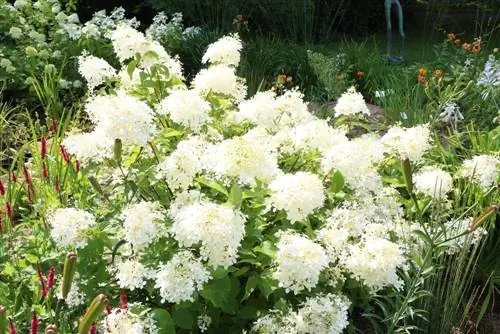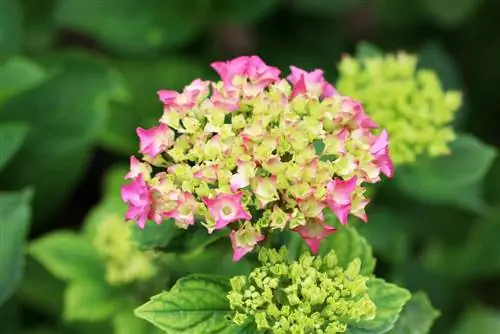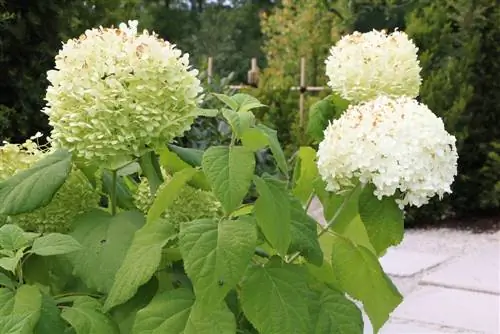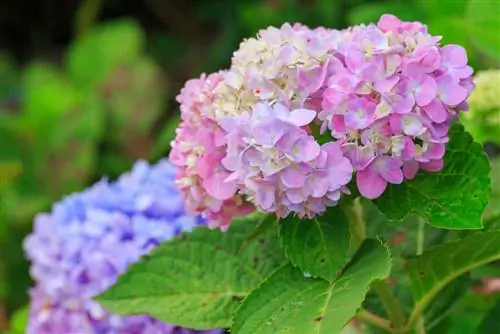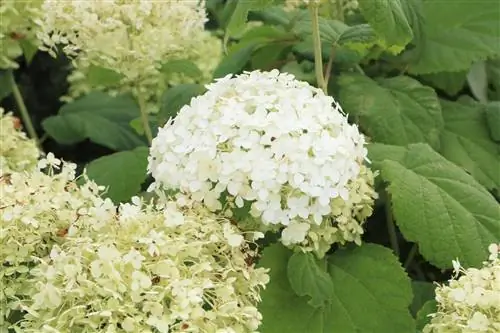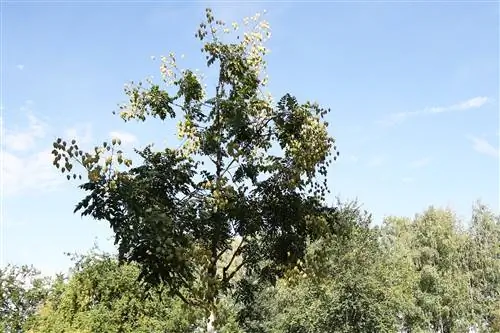- Author admin [email protected].
- Public 2023-12-17 03:39.
- Last modified 2025-01-24 12:45.
The panicle hydrangea is a hydrangea plant that originally comes from East Asia and was first described in 1830 by the botanist Philipp Franz von Siebold in Japan. The plant appears either as a strong shrub or small tree that can reach heights of up to five meters with proper care. The late bloomer delights with beautiful flowers.
The right location
When caring for Hydrangea paniculata, the main thing to pay attention to is the right location, as the shrub is very demanding in this area. The location should be as follows:
- sunny to partially shaded
- sheltered from the wind
- sandy, loamy, fresh, moist
- acidic or neutral soil
- Incompatible with limescale
- nutrient-rich
- Planting distance: 1 meter
- should be deep enough
Since the hydrangea likes to settle in the ground, you should make sure there is enough space under the plant so that the roots are not restricted. Due to its tendency to break off when winds are too strong, the location should always be chosen so that it is not exposed to wind, especially during the flowering period. Many gardeners have had to watch their panicle hydrangea let its shoots droop because it couldn't tolerate the gusts. Once a suitable location has been chosen, much of the necessary care has already been completed.
Tip:
You can also easily plant Hydrangea paniculata in large pots and place it on the terrace. This means you can adapt the location directly to the needs of the plant if, for example, your garden is too open and cannot therefore provide wind protection.
Pouring
Watering a panicle hydrangea is quite simple and depends on the weather. It is still very thirsty and should be watered regularly so that it does not dry out. You can water extensively every day without any worries and young plants in particular will be grateful to you. In summer, care must be taken to water enough, especially in the evening, as the warm days severely deplete the plant's water supply.
The shrub loves it when the roots are a little moister as long as it is in the ground. Things are different with potted plants. Although they need to be watered regularly, waterlogging should be avoided at all costs, otherwise the roots cannot process the nutrients in the soil quickly enough. When it comes to water, you should make sure that it contains little or, ideally, no lime at all. Lime is a major weakness of the panicle hydrangea and often causes the plant to grow poorly.
Fertilize
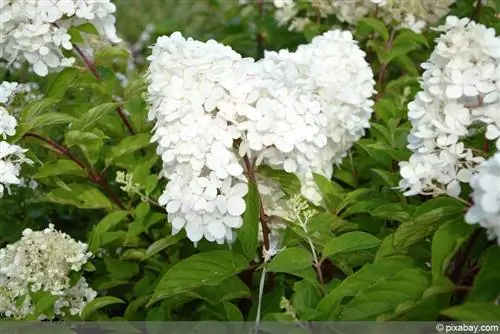
Fertilizing Hydrangea paniculata occurs throughout the year and begins in spring with a complete, mineral-based fertilizer that contains little phosphorus. If the soil is nutrient-poor, regular fertilization over a period of two weeks is recommended, as this allows the fast-growing hydrangea to receive enough nutrients that it needs to grow.
From summer onwards, a long-term fertilizer is recommended, which also contains little phosphorus and more nitrogen. If you have planted the hydrangea in nutrient-poor soil, you should definitely use a complete fertilizer, otherwise it will not have enough nutrients. If the soil has sufficient nutrients, it is not absolutely necessary to use a complete or slow-release fertilizer. Here, a layer of compost placed around the roots is sufficient to nourish the panicle hydrangea. The compost also acts as a water reservoir, which is always an advantage with Hydrangea paniculata.
Pests and diseases
The panicle hydrangea does not often suffer from diseases and pest infestation is also rather rare, but if the substrate in the pot is too wet, an infestation of aphids can occur. Make sure there is good drainage here and, if necessary, repot the plant in a fresh, dry substrate. If the soil is too alkaline and low in iron, the hydrangea can suffer from chlorosis, which is noticeable as yellowish leaves with greenish veins.
Treatment with peat or rhododendron soil, which is mixed into the soil, is recommended. Additionally, you should fertilize immediately. Chlorosis occurs due to a nutrient deficiency, which can be counteracted by these measures. In addition, you should avoid too much moisture on the leaves of the Hydrangea paniculata, as it often suffers from powdery mildew. This means watering the plant from below and being careful not to wet the leaves, especially if the water is hard.
Cut
There are two different cutting shapes for the panicle hydrangea and these help the plant to maintain its otherwise lush growth. Since Hydrangea paniculata grows quite quickly, growth will always stop if it is not cut. For this reason, the following cuts are regularly used:
- pruning
- Blending
pruning

Pruning is the most important pruning for the panicle hydrangea to allow for the lush, green display of foliage it is known for. In total, the plant can grow up to 50 centimeters per year when pruned, which is what makes it so popular with many gardeners. Even a strong pruning is not bad for the hydrangea. The pruning should be carried out at the end of February at the latest, even a little earlier is better.
This stimulates the plant to sprout and thus ensures a true display of flowers in late summer. Another option is to prune in late autumn, but the shoots provide good winter protection for the plant. The following instructions will guide you through all the steps necessary for successful cutting:
- For pruning, choose clean secateurs or pruning shears, depending on the age of the hydrangea.
- Look for all shoots that have dried up and do not yet have fresh sprouts. It can happen that the panicle hydrangea forms buds or eyes in winter, and for this reason these shoots should not be cut off. However, all dried shoots from the previous year can be cut back without any problems.
- After you have located all the shoots that have dried up, remove them with scissors. You have to shorten the hydrangea to just a few centimeters. The remaining stubs should have a pair of eyes. This severe pruning is necessary in order to be able to provide the panicle hydrangea with enough energy for the coming season. With this cut, the hydrangea will be able to double in size in the coming season because two new shoots will then sprout from the individual shoots. This means that the hydrangea not only becomes taller, but also more lush.
- Do not be too careful with the plant while pruning. She is not sensitive to cutting.
- After you have cut back the entire plant, you should then collect the greenery and prepare the ground for spring, especially for sudden frosts.
Tip:
If you cut the hydrangea back even further and leave small stubs everywhere, you will end up with a small shrub that is very suitable as a pot plant. The shrub takes on a rounded shape with large flowers.
Blending
When thinning out the panicle hydrangea, dead branches and buds are removed throughout the year. It is not necessary to remove wilted flowers as they provide perfect protection for the shoots over the winter. Thinning is especially important when branches and shoots break due to external influences or wind. Thinning is also recommended for gardeners who are afraid of severe pruning or who want to allow the hydrangea to grow naturally. You proceed as follows when thinning out:
- Observe throughout the year whether shoots on the plant have dried up or broken off. If this is the case, scissors should only be used on really thick shoots. Otherwise the affected area should only be removed by hand. Also pay attention to crooked, overlapping or diseased shoots that need to be removed.
- The early morning hours are a good time, as the plant then has time to recover from the procedure and let the shoots dry.
- First remove the dried shoots by hand, if possible, and continue the work with scissors. You can thin out the entire plant a little and determine your own growth habit. However, especially in summer, be careful not to cut off too many he althy and new shoots.
- As with pruning, remove the greenery and water the plant thoroughly. After thinning, adding water is necessary.
Natural shape
Many gardeners are increasingly being inspired by the natural growth habit of the panicle hydrangea, which still occurs in many areas in Asia. With this form, the hydrangea is never cut back, but is carefully thinned out throughout the year and the withered flowers from the previous season are removed in spring. Hydrangeas tend to have unique growth habits if they are never pruned and can take the shape of a roof or a sprawling tree, for example.
The actual care for this growth form is carried out in the same way as for the cut specimens. Although your hydrangea will become larger in the long term without being cut, it will grow without a shape. Only the upright growth is typical, because part of the bush always grows towards the sky.
Wintering
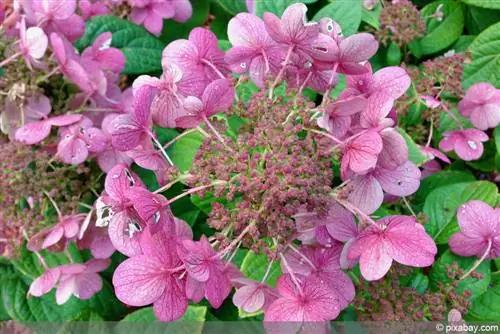
The panicle hydrangea is an extremely winter-hardy plant that can even withstand temperatures of -40°C and even prepares itself for winter. Due to its special growth, the panicle hydrangea does not need any real preparation for winter, but a routine is recommended for young plants in the first year that protects the young shoots and especially the fresh roots from the cold.
Older plants can easily overwinter without protection as long as the location is chosen correctly. Icy winds in winter can kill it and prevent it from sprouting next spring. Prepare your young plant and, if necessary, an older panicle hydrangea for winter with these steps:
- Only remove flowers in late fall if you live in a climate with mild winters without much snow. If not, leave the withered flowers on the plant. They act as insulation against the cold and are also an aesthetic accent in the garden when the snow falls on the flowers.
- Free the plant's location of leaves and cover the ground near the roots with a generous mat of brushwood. This is necessary in particularly cool areas to protect the root ball.
- If spring is coming quickly next year and the plant is already starting to sprout, you should make sure to cover the plants in fleece, especially around May (Ice Saints). This means you won't freeze to death in the event of a sudden cold snap.
- After the winter, this insulation can then be removed.
Overwintering in a pot
Hydrangea paniculata has no problem overwintering in a pot. If the pot is larger than 30 centimeters in diameter, it can easily be left outdoors as long as there are no strong winds. Small specimens, on the other hand, should be kept in the winter garden at three to five degrees Celsius. They are still too sensitive to overwinter outside.

